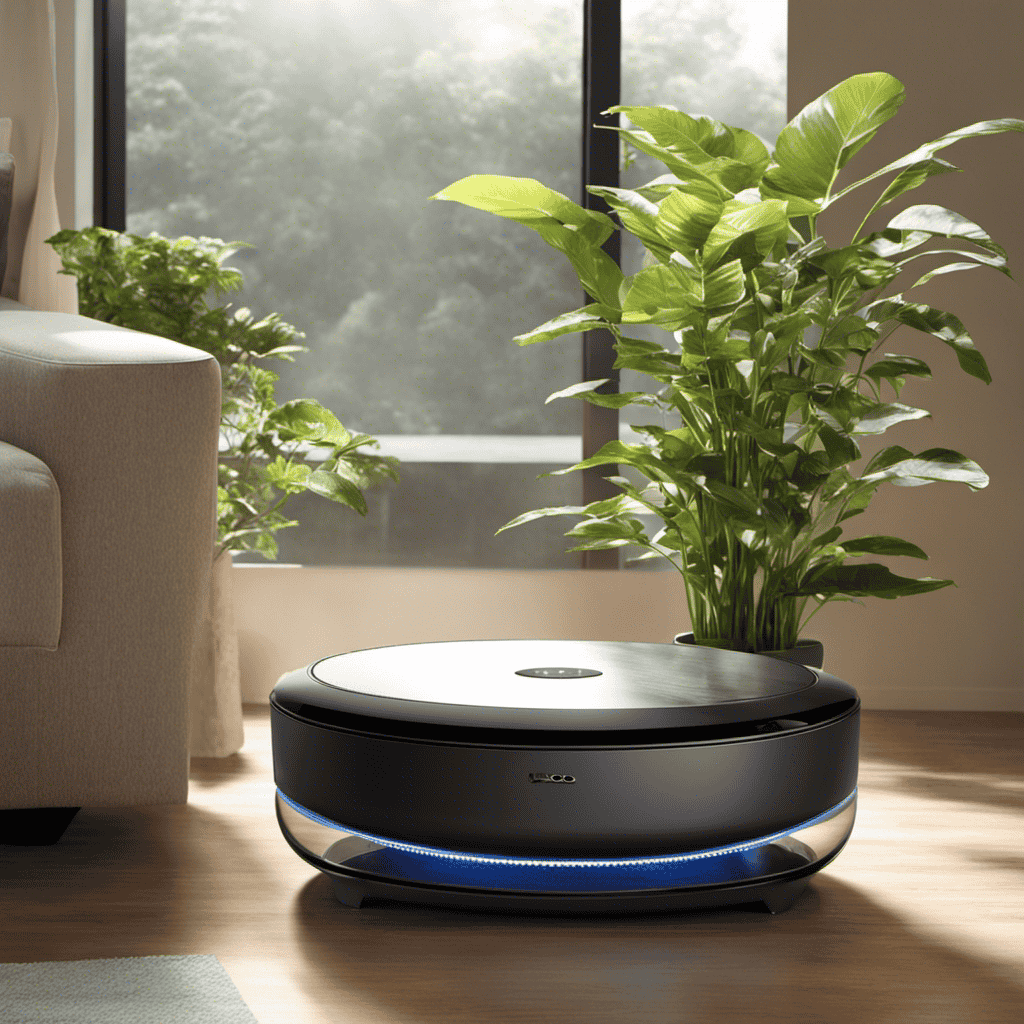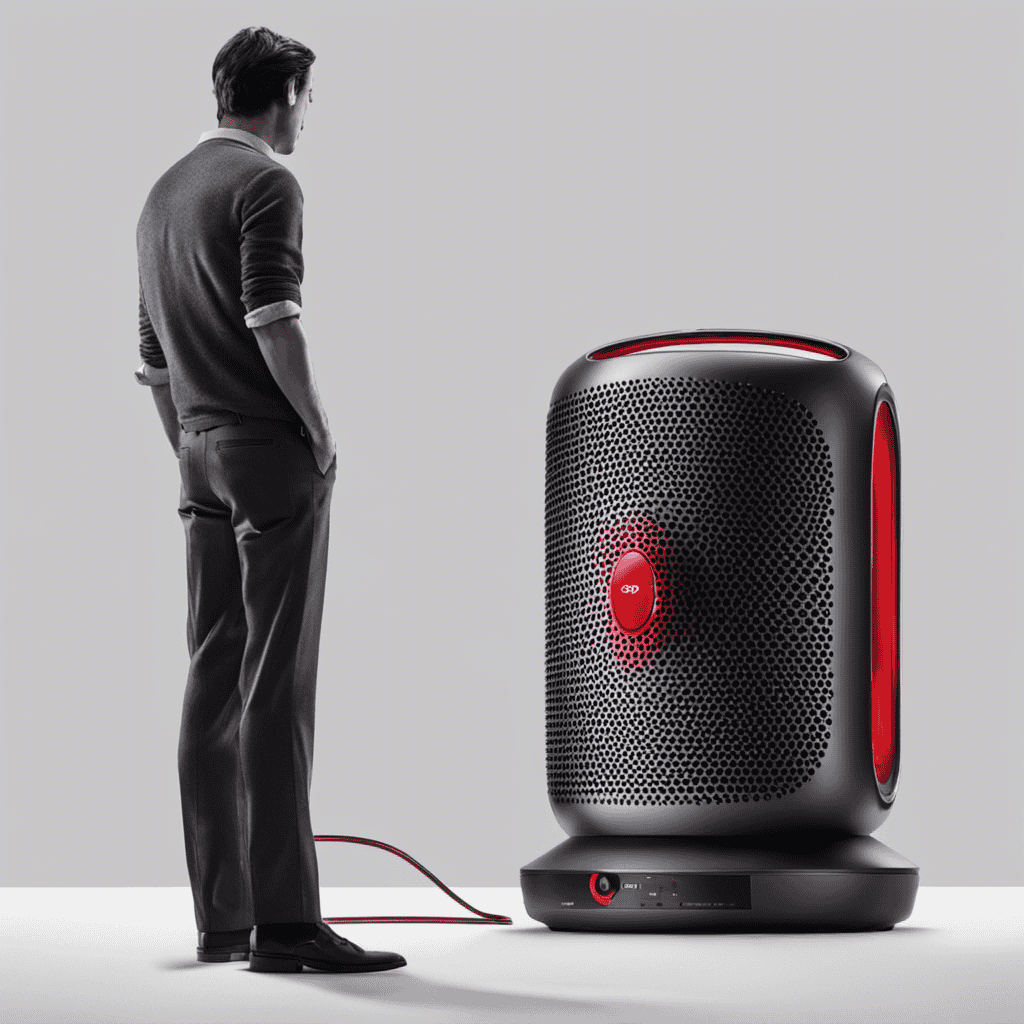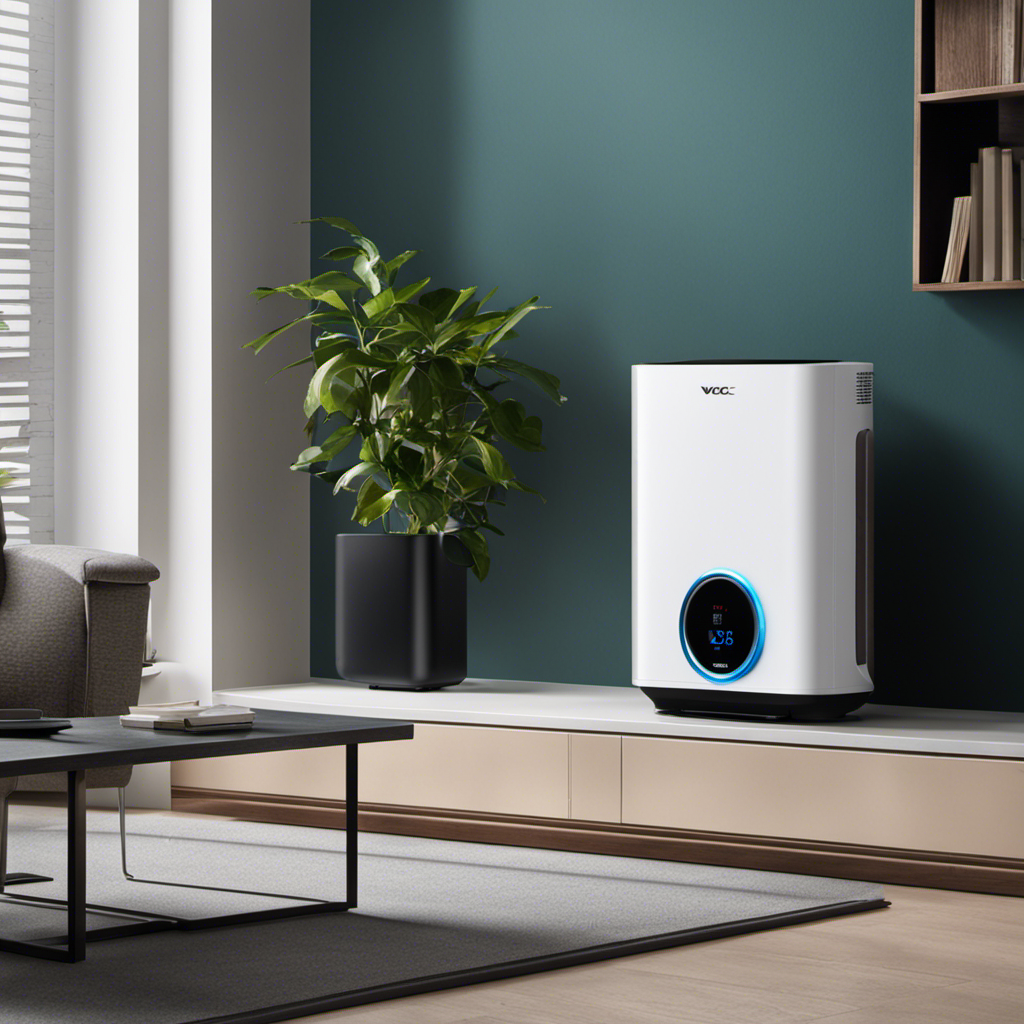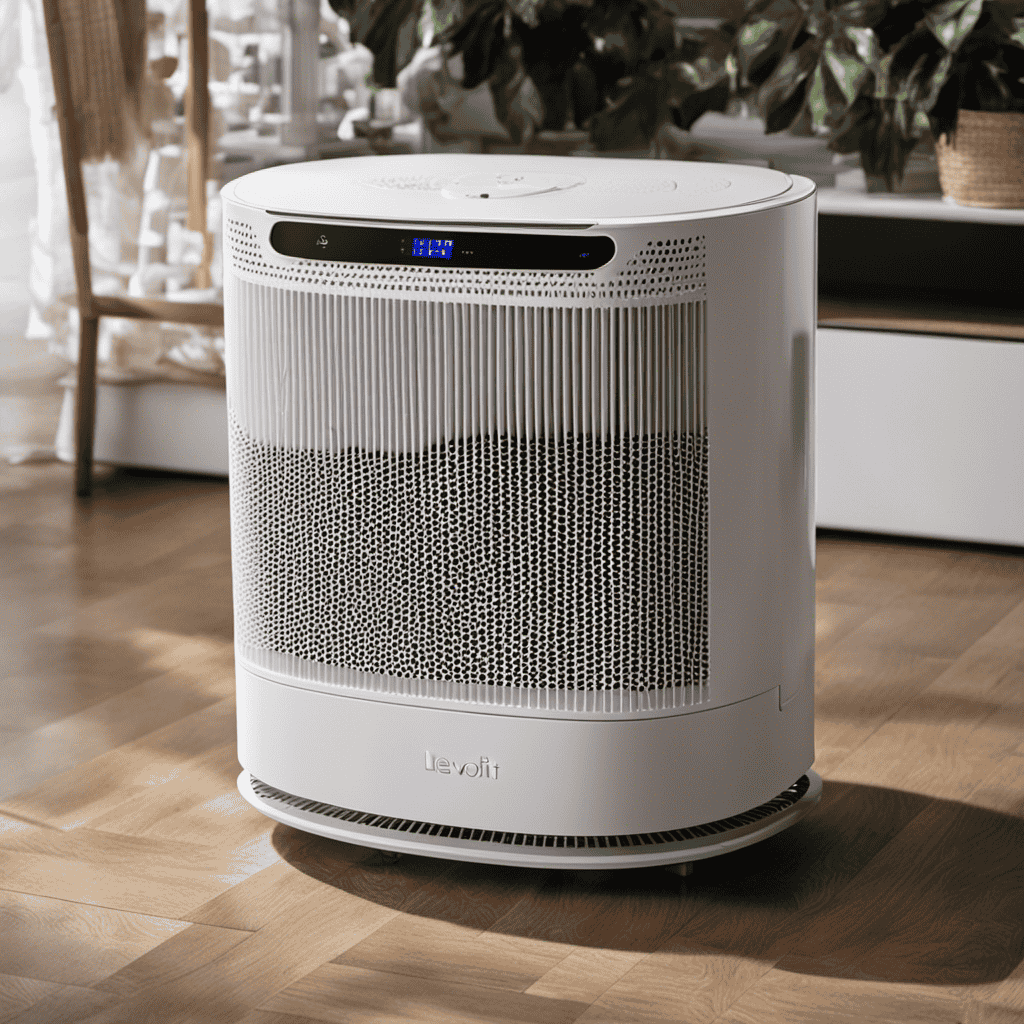As someone who appreciates clean and fresh air, I can confidently attest that having an air purifier is akin to experiencing a breath of fresh air in your home.
In this article, we will explore the numerous health benefits of air purifiers and how they improve indoor air quality.
From reducing allergens and managing asthma symptoms to eliminating odors and smoke, air purifiers play a crucial role in maintaining a healthy and comfortable living environment.
So, let’s dive into the science behind why you should have an air purifier.
Key Takeaways
- Air purifiers improve indoor air quality by removing pollutants such as dust, pet dander, and chemicals.
- Air purifiers capture and eliminate harmful pollutants, improving overall respiratory health.
- Air purifiers significantly reduce allergens and improve indoor air quality, reducing allergy symptoms.
- Air purifiers help manage asthma symptoms by removing allergens and irritants from the air.
Health Benefits of Air Purifiers
Air purifiers can significantly improve the air quality in your home, reducing the risk of allergies and respiratory issues. Indoor air pollution is a major concern, with various sources such as dust, pet dander, and chemicals contributing to poor air quality. However, there are ways to combat this problem, and one effective solution is using an air purifier.
Studies have shown that air purifiers can effectively remove pollutants from the air, including those that can trigger allergies and respiratory problems. These devices work by using filters or other technologies to capture and trap particles, such as pollen, mold spores, and volatile organic compounds (VOCs). By removing these pollutants, air purifiers help create a healthier indoor environment.
In addition to using air purifiers, another natural way to improve indoor air quality is by incorporating indoor plants into your home. Plants have the ability to remove toxins from the air through a process called phytoremediation. They absorb harmful gases and release oxygen, acting as natural air purifiers. Studies have shown that certain plants, such as snake plants and peace lilies, are particularly effective in removing pollutants like formaldehyde and benzene.
Overall, air purifiers, along with the presence of indoor plants, can significantly improve the air quality in your home. By reducing the presence of allergens and pollutants, these measures can help prevent allergies and respiratory issues, promoting a healthier living environment.
How Air Purifiers Improve Indoor Air Quality
Air purifiers play a crucial role in improving indoor air quality by effectively removing harmful pollutants. These devices are designed to capture and trap particles such as dust, pollen, pet dander, and mold spores, which are known to trigger allergies and respiratory issues.
Removes Harmful Pollutants
Using an air purifier can effectively remove harmful pollutants from your home. Air purification benefits are well-documented and supported by scientific evidence.
Air purifiers work by using filters or other technologies to capture and eliminate pollutants such as dust, pet dander, pollen, mold spores, and volatile organic compounds (VOCs). These pollutants can have detrimental effects on our health, especially for individuals with allergies, asthma, or other respiratory conditions.
Reduces Allergy Symptoms
To alleviate your allergy symptoms, an air purifier effectively reduces the presence of airborne allergens in your home. By capturing and trapping allergens such as pollen, dust mites, pet dander, and mold spores, an air purifier can significantly decrease the amount of these triggers in the air you breathe. This reduction in allergens can lead to a decrease in inflammation, as exposure to allergens can cause an immune response that results in inflammation in the body. By reducing inflammation, an air purifier can help alleviate symptoms such as sneezing, coughing, and itchy eyes.
In addition to reducing inflammation, an air purifier can also improve sleep quality for individuals with allergies. Studies have shown that exposure to allergens during sleep can disrupt sleep patterns, leading to poor sleep quality and daytime fatigue. By removing allergens from the air, an air purifier can create a cleaner and healthier sleep environment, allowing for a more restful and uninterrupted sleep.
To further emphasize the benefits of using an air purifier, the following table provides a comparison of the most common types of filters used in air purifiers:
| Filter Type | Efficiency in Capturing Allergens | Lifespan | Maintenance |
|---|---|---|---|
| HEPA Filter | High | 6-12 months | Replacement |
| Activated Carbon Filter | Moderate | 3-6 months | Replacement |
| Ionic Filter | Low | Permanent | Cleaning |
Based on this comparison, it is evident that HEPA filters are the most effective in capturing allergens, with a high efficiency rate. However, they require replacement every 6-12 months. On the other hand, activated carbon filters have a moderate efficiency rate and require replacement every 3-6 months. Ionic filters have a low efficiency rate but are permanent and only require regular cleaning.
Enhances Overall Respiratory Health
By reducing the presence of airborne allergens, an air purifier can improve overall respiratory health. Air purifiers are an effective prevention method for respiratory issues caused by allergies and pollutants.
They filter out harmful particles, such as pollen, dust mites, and pet dander, that can trigger asthma or other respiratory conditions. The long-term benefits of using an air purifier include reduced symptoms and improved lung function.
Studies have shown that air purifiers can significantly decrease the levels of indoor air pollutants, leading to fewer respiratory symptoms and a lower risk of developing respiratory diseases. Additionally, air purifiers can help remove volatile organic compounds (VOCs) and other harmful chemicals from the air, further enhancing respiratory health.
Investing in an air purifier is a smart choice for those looking to improve their overall well-being and respiratory function.
Reducing Allergens With an Air Purifier
By having an air purifier in your home, you can significantly reduce allergens and improve your indoor air quality. When it comes to choosing an air purifier, there are various brands available in the market. Some popular brands include Dyson, Honeywell, and Blueair. Each brand offers different models with varying features and capabilities. The cost of air purifiers can vary depending on the brand, model, and additional features you may require.
Air purifiers work by filtering out airborne particles such as dust, pollen, pet dander, and mold spores. They use filters to trap these particles and prevent them from circulating in your indoor air. HEPA (High-Efficiency Particulate Air) filters are considered the most effective in capturing allergens and other fine particles. These filters can remove up to 99.97% of particles as small as 0.3 microns in size.
Investing in an air purifier can be beneficial for individuals who suffer from allergies or asthma. Studies have shown that using air purifiers can reduce the symptoms of allergies and improve respiratory health. It is important to note that while air purifiers can be effective in reducing allergens, they should not replace proper cleaning and maintenance practices in your home.
The Role of Air Purifiers in Asthma Management
Using an air purifier can be beneficial in managing asthma symptoms and improving respiratory health. As a sufferer of asthma, I have experienced firsthand the positive effects that an air purifier can have on my overall well-being.
Here are some key points regarding the role of air purifiers in asthma management:
- Air purifiers help remove allergens and irritants from the air, reducing the triggers that can worsen asthma symptoms.
- They can improve sleep quality by eliminating airborne particles that can cause nighttime coughing and wheezing.
- Air purifiers have been shown to have a positive impact on children’s health, especially those with asthma. By providing cleaner air, they can reduce the frequency and severity of asthma attacks in children.
Numerous studies have demonstrated the effectiveness of air purifiers in reducing asthma symptoms and improving respiratory health. These devices work by filtering out airborne particles such as dust, pollen, pet dander, and mold spores, which are known triggers for asthma. By removing these irritants from the air we breathe, air purifiers can create a healthier indoor environment for asthma sufferers.
In addition to managing asthma, air purifiers also play a crucial role in eliminating odors and smoke.
Eliminating Odors and Smoke With an Air Purifier
As we discussed earlier, air purifiers play a crucial role in managing asthma symptoms by filtering out allergens and pollutants from the air. However, their benefits extend beyond just asthma management.
One of the key advantages of having an air purifier is its ability to eliminate odors and smoke, thereby improving air quality in our living spaces. Air purifiers are equipped with filters that are designed to trap and remove various types of pollutants, including smoke particles and volatile organic compounds (VOCs) that contribute to unpleasant odors. These filters effectively capture and neutralize the molecules responsible for these smells, allowing us to breathe cleaner and fresher air.
In addition, air purifiers can also help remove smoke particles from the air. Whether it’s from cigarettes, cooking, or wildfires, smoke can significantly impact our health and well-being. By capturing and filtering out these harmful particles, air purifiers can reduce our exposure to smoke, minimizing its adverse effects on our respiratory system.
Overall, incorporating an air purifier into our homes can greatly contribute to improving air quality and creating a healthier indoor environment.
Now, let’s delve into another important aspect of air purifiers: what pet owners need to know about using them.
Air Purifiers and Pet Owners: What You Need to Know
If you’re a pet owner, it’s important to understand how air purifiers can benefit your furry companions. As a pet owner myself, I have experienced the challenges of maintaining good air quality in my home. Pet dander, which includes dead skin cells, fur, and feathers, can contribute to poor air quality and potentially trigger allergies or respiratory issues in humans. However, with the use of an air purifier, these concerns can be effectively addressed.
Here are three key ways in which air purifiers can benefit both you and your pets:
-
Reduction of pet dander: Air purifiers are equipped with filters that can capture and remove pet dander particles from the air. This helps to minimize the amount of airborne allergens, improving the overall air quality in your home.
-
Odor elimination: Along with pet dander, air purifiers can also help to eliminate pet odors. They are designed to trap and neutralize odorous molecules, leaving your home smelling fresh.
-
Improved respiratory health: By removing pet dander from the air, air purifiers can reduce the risk of respiratory issues in both humans and pets. This is particularly beneficial for individuals with allergies or asthma.
Choosing the Right Air Purifier for Your Home
When selecting the right air purifier for your home, it’s important to consider factors such as room size, filter types, and noise levels. Air purifiers come with a variety of features that can enhance their effectiveness in improving indoor air quality.
One important feature to consider is the type of filter used in the purifier. High-efficiency particulate air (HEPA) filters are considered the gold standard as they can capture particles as small as 0.3 microns, including allergens, dust, and pet dander. Another useful feature is the presence of an activated carbon filter, which can help remove odors and chemicals from the air.
Noise levels can also be an important consideration, especially if you plan to use the air purifier in a bedroom or office space.
Cost considerations should also be taken into account when selecting an air purifier. While some models may have a higher upfront cost, they may offer long-term savings in terms of filter replacement costs. It’s important to research and compare different models to find the one that best fits your budget and needs.
In order to ensure the optimal performance of your air purifier, regular maintenance and care are necessary.
Maintenance and Care Tips for Air Purifiers
When it comes to maintaining and caring for air purifiers, two key factors to consider are the cleaning frequency and the guidelines for filter replacement.
It is important to determine how often the air purifier needs to be cleaned, as this will ensure its optimal performance and efficiency in removing airborne pollutants.
Additionally, understanding the recommended filter replacement guidelines is crucial in order to maintain the air purifier’s effectiveness in filtering out contaminants.
Cleaning Frequency for Air Purifiers
The recommended cleaning frequency for air purifiers is typically every three to six months. Regular cleaning ensures that the air purifier continues to function effectively and efficiently. Neglecting to clean the device can result in reduced performance and even damage to the unit. It is important to follow the manufacturer’s instructions for cleaning, as different air purifier brands may have specific cleaning requirements.
Regular cleaning of air purifiers offers several benefits:
-
Improved air quality: Cleaning removes accumulated dust, allergens, and pollutants from the filters, allowing the air purifier to effectively capture and remove airborne particles.
-
Longevity of the unit: Regular cleaning helps to prolong the lifespan of the air purifier, preventing clogging and reducing strain on the motor.
-
Cost-effectiveness: By cleaning the air purifier regularly, you can avoid the need for frequent filter replacements, saving on the cost of air purifiers in the long run.
Filter Replacement Guidelines
Replacing the filters in your air purifier on a regular basis is essential for maintaining its effectiveness and ensuring clean air in your indoor space. Proper filter maintenance is vital to maximize the lifespan of your filters and to optimize the performance of your air purifier.
The filter lifespan can vary depending on factors such as the quality of the air in your environment and the type of filter used. However, as a general guideline, it is recommended to replace the filters every 3 to 6 months.
Regularly inspecting the filters for dirt, dust, and debris accumulation is crucial. If the filters appear dirty or clogged, it is time to replace them.
Frequently Asked Questions
How Much Energy Does an Air Purifier Consume?
Air purifiers consume varying amounts of energy depending on their size, features, and usage. Energy consumption is primarily determined by the fan motor and any additional features such as air quality sensors or timers.
It is important to consider the energy efficiency rating of an air purifier before purchasing. Additionally, filter replacement is another factor to consider as it can affect the overall energy consumption. Regular filter replacement ensures optimal performance and energy efficiency.
Can an Air Purifier Completely Eliminate All Allergens From the Indoor Air?
An air purifier can be highly effective in reducing allergens from indoor air. It works by filtering out particles such as pollen, dust, and pet dander, which are common triggers for allergies.
While it may not completely eliminate all allergens, it significantly improves air quality and reduces the risk of allergic reactions.
Using an air purifier has numerous benefits, including providing relief to individuals with allergies and improving overall respiratory health.
Are There Any Risks or Side Effects Associated With Using an Air Purifier?
There are some risks associated with using an air purifier, but the benefits outweigh them.
Some purifiers produce ozone, which can irritate the lungs and worsen respiratory conditions. However, most modern purifiers are ozone-free and safe to use.
Studies have shown that air purifiers can reduce indoor air pollution, alleviate allergies, and improve overall air quality.
It’s important to choose a reputable brand and follow proper maintenance to maximize the benefits and minimize any potential risks.
Can an Air Purifier Remove Harmful Gases and Chemicals From the Air?
Air purifiers are effective at removing harmful gases and chemicals from the air. They use filters and other technologies to capture and neutralize these pollutants, improving indoor air quality.
The efficiency of an air purifier in removing specific gases and chemicals depends on factors like the type of filter and the size of the pollutant particles. However, overall, air purifiers are a reliable solution for reducing the presence of harmful substances in the air we breathe.
Are There Any Specific Air Purifiers Recommended for People With Respiratory Conditions Other Than Asthma?
When it comes to respiratory conditions and allergies, having an air purifier can be beneficial. It helps to remove airborne pollutants and allergens, improving indoor air quality.
While there are no specific air purifiers recommended for respiratory conditions other than asthma, look for ones with HEPA filters. These filters are effective in capturing particles as small as 0.3 microns, such as pollen, pet dander, and dust mites.
This can provide relief for individuals with respiratory conditions and allergies.
Conclusion
In conclusion, after thoroughly investigating the benefits of air purifiers, it is evident that they play a crucial role in improving indoor air quality.
Scientific evidence supports the fact that air purifiers can effectively reduce allergens, manage asthma symptoms, and eliminate odors and smoke.
For pet owners, air purifiers are particularly beneficial in removing pet dander and other allergens.
When choosing an air purifier, it is essential to consider specific factors and perform regular maintenance to ensure optimal performance.
Overall, investing in an air purifier is a wise decision for a healthier and cleaner indoor environment.










